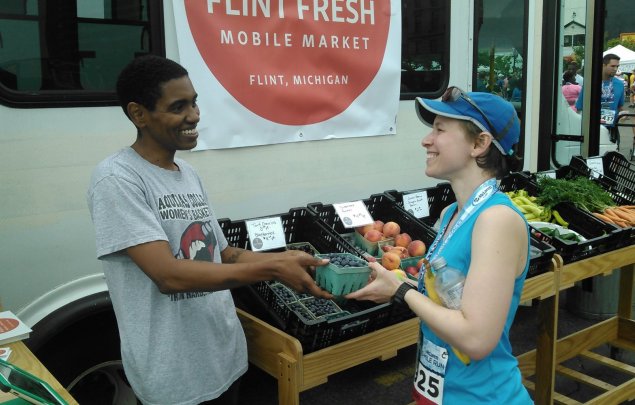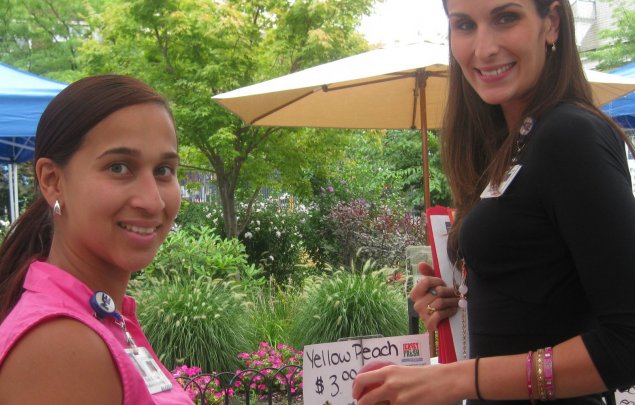Honoring local knowledge, growing health, and improving equity
Takeaways
- New Mexico is ranked 37th in the country for overall health and often has some of the worst rankings for social indicators of health, including rates higher than the national average for poverty, low food access, and food insecurity.
- Presbyterian Hospital is involved with three innovative projects focused on improving food access and health equity, made possible by their community benefit investments and cross-sector partnerships:
- La Cosecha Community Supported Agriculture
- Healthy Here Mobile Farmers Market
- Healthy Here Wellness Referral Center
- Presbyterian’s food-related work is part of a system-wide effort coordinated by their Center for Community Health. The center has grown from one staff person to fifteen within the last five years, demonstrating the health system’s strong commitment.
- The Center for Community Health has leveraged over $12.5 million in funding to help sustain their community health improvement work.
- Hospital Name: Presbyterian Hospital
- Hospital Type: Private, nonprofit; critical access
- Hospital Size: Large (453 beds)
- Geographic area: Metropolitan
- System/Network: Presbyterian Healthcare Services (PHS)
- Network coverage: New Mexico
- Black: 2.8%
- American Indian & Alaska Native: 4.42% (as compared to 0.82% of U.S. population)
- Asian: 2.35%
- White: 71.74%1
- Community health needs assessment region: Central New Mexico (5-county region that includes Bernalillo County where Presbyterian Hospital is located)
- Population (Bernalillo County): 671,429
- Obesity: 20.3% are obese
- Diabetes: 6.2% have diabetes2
- Food insecurity: 15.4% experience food insecurity3
- Low food access: 22.86% experience trouble accessing food4
- Poverty: 18.59% experience financial instability5
- Unemployment: 5% experience job insecurity6
Albuquerque sits in the high desert straddling the Rio Grande River. It is the largest city in New Mexico, but despite the predominantly urban setting, there are still many areas with limited access to grocery stores and a lack of affordable produce. These factors contribute to the low rates of healthy food access and food security and the resulting high rates of chronic diseases like diabetes and heart disease.
However, the burden of these community health problems is not equitably shared. The South Valley and the International District of Albuquerque are two areas of the city with the highest rates of poverty and health disparities. Presbyterian Center for Community Health is working strategically in these areas to develop innovative approaches to addressing the most pressing health needs in the community.
Presbyterian Healthcare Services (PHS) is the largest health system in New Mexico and has eight hospitals and thirteen primary care clinics throughout the state. Based in Albuquerque is Presbyterian Hospital (Presbyterian), the system’s flagship hospital and the largest acute care hospital in New Mexico.
Part of what makes Presbyterian’s efforts successful is identifying and leveraging existing community strengths. The International District is the state’s most diverse legislative district and is known not only for its diversity but also for its great food. The South Valley region has a long history of farming culture and this case study highlights the partnerships between farmers and health professionals that are improving food access for the community.
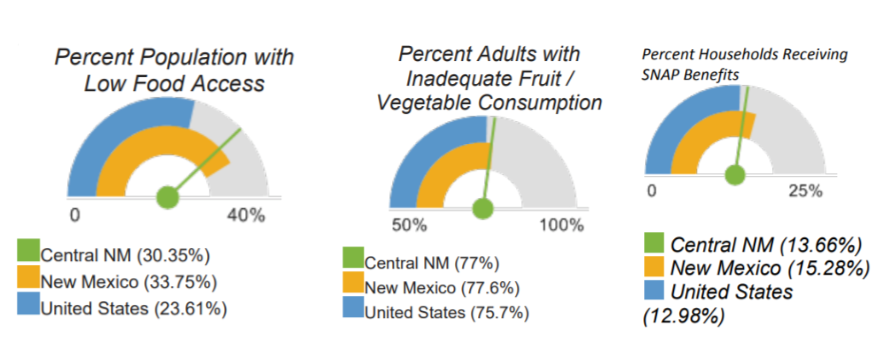
Community health needs assessment: Priorities and process
- Food and diet-related disease priorities
- 2013 CHNA - healthy eating
- 2016 CHNA - healthy eating
- Participation from food-based organizations in CHNA process
- Kids Cook!, ICAN Program (Ideas for Cooking and Nutrition) at the New Mexico State University Cooperative Extension Service
- How/why did food issues emerge as a priority?
- In the 2013 CHNA, healthy eating was prioritized as a root cause of health. It continues to have a significant impact on the health of communities throughout New Mexico and was prioritized again in the 2016 CHNA.
- Food insecurity is the primary barrier to making progress on this healthy eating strategy. Therefore, specific focus areas within the overall strategy include: improving food access, supporting growers markets, and changing policy.
- Key community indicators
- Nearly one in four people living in Bernalillo County have trouble accessing food.
- New Mexico has a higher-than-average rate of food insecurity, especially among children: One in three children is food insecure.
Full assessment: Presbyterian’s 2016 Community Health Needs Assessment for Central New Mexico
Assessing health needs — and how to meet them
Community health needs assessment process
Presbyterian has been working actively to address community health needs that fall outside the scope of traditional medical care since 2013. One example is the health system’s implementation of New Mexico’s Child and Adult At-Risk Feeding Program and the Summer Feeding Program. As part of these programs, Presbyterian Hospital is one of five hospitals in the state where community members can walk-in and receive a free meal in the cafeteria. The program at Presbyterian Hospital served 2,000 children last year, demonstrating the immense need within the Albuquerque community that Presbyterian is stepping up to fill.
In 2016, the health system formalized this focus on community health improvement by establishing the Center for Community Health. The center is based at Presbyterian Hospital in Albuquerque and organizes the entire health system’s efforts to address the health needs of underserved populations through funding, programmatic support, and cross-sector collaborations. Leigh Caswell is the Director of Presbyterian’s Center for Community Health and oversees a staff of fifteen. The growth of the center from one staff person to fifteen demonstrates the health system’s strong commitment to addressing the social determinants of health.
- Leigh Caswell, Director of Presbyterian’s Center for Community Health
One specific function of the center is to coordinate the community health needs assessments (CHNA) and implementation plans for the counties where their hospitals are located. In 2016, the center coordinated six CHNAs which involved covering health assessment for much of New Mexico. To meet this challenge, they used the state’s non-traditional health department structure to work in their favor and succeeded in creating a streamlined process that draws more directly on the communities experiences.
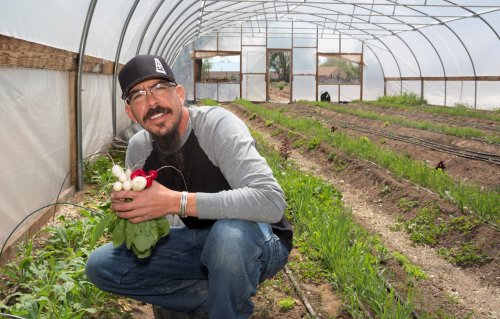
In Bernalillo County, where Presbyterian Hospital is located, the assessment process was part of a larger “Central New Mexico Community Health Needs Assessment.” To inform the development of the Central New Mexico CHNA, the center contracted with nine county health councils. They compensated each council $5,000 to identify significant health needs in their respective counties. The methods used by the health councils varied. For example, the Bernalillo County Community Health Council conducted meetings and sent out surveys to solicit input from community members and public health experts.
The Center for Community Health then consolidated and prioritized the identified health needs by considering which contribute most significantly to chronic disease, injury and mortality, poor health and quality of life, and high health care costs.
The resulting priorities from the 2016 Central New Mexico CHNA included:
- healthy eating
- active living
- and prevention of unhealthy substance use
While all nine health councils identified food and nutrition in some form, the Bernalillo County Community Health Council specifically called out “access to affordable healthy food” as a priority. This focus on access, as opposed to behavior also plays a part in the implementation strategy, as well as in the projects highlighted in this case study.

Investing in solutions
Implementation strategy
The Center for Community Health also relies on the health councils during the process to develop implementation strategies (comprehensive plans that accompany each CHNA to take action on the prioritized health needs). At this stage, the health councils identify gaps in community resources as well as community strengths to determine the specific activities and interventions that will be written into the implementation strategies.
This year, the center tried a new process and granted each health council $20,000 to build staff capacity and carry out parts of their county’s implementation strategy. The center also strategically funds more than 60 community-based organizations across ten counties to help with specific interventions.
Bernalillo County Community Health Council has partnered closely with Presbyterian Hospital over the years to form the Healthy Here Initiative. In 2014, the Healthy Here Initiative was awarded a Racial and Ethnic Approaches to Community Health (REACH) Cooperative Agreement from the Centers for Disease Control and Prevention (CDC), and Presbyterian was designated to manage the award.
As part of the cooperative agreement, the Healthy Here Initiative links several sectors of the local food system to improve health in priority communities. Therefore, the implementation strategy for Bernalillo County has a strong focus on increasing access to healthy food in communities with high rates of poverty, low educational attainment, and high percentages of Native American and Hispanic residents. In Bernalillo County, 4.42 percent of the population is Native American (as compared to 0.82 percent of the U.S. population) and 49.7 percent of the population is Hispanic or Latino.
The interventions highlighted in this case study are a result of the perfect storm in Bernalillo County that brought together a hospital committed to addressing high rates food insecurity in their patient population, a diverse set of stakeholders committed to creating a more equitable food system, and an infusion of funding. These projects include: a community supported agriculture program, a mobile farmers market, and a wellness referral center.
Project spotlights
La Cosecha
La Cosecha is a community-supported agriculture program organized by the Agri-Cultura Cooperative Network that offers subsidized locally grown produce shares for food-insecure community members while also investing in local farms.
- Program type: Community supported agriculture
- Program administrator: Agri-Cultura Cooperative Network
- Program founded: 2011
- Hospital role: Provide grant support
- Community partners: Agri-Cultura Cooperative Network and 17 partner organizations that serve as weekly distribution sites for the CSA
- Population served: People in the South Valley and International District of Albuquerque who self-report as low-income and who are struggling with food insecurity
- Program goals: Increasing consumption of healthy food, increasing community knowledge about how to use whole foods, improving the economic situation of local food producers and providing farmers with viable jobs, and decreasing community food insecurity
- Health needs addressed: Healthy eating
- Program highlight: The program has grown from serving 20 families to 375 families, and provides some of the participating farmers with 62 percent of their income.
“We are developing a secure food system. The food is grown here, and stays here, and that has a big impact economically as well as on the health of our communities.”
- Helga Garcia-Garza, Co-Director of the Agri-Cultura Cooperative Network.
Project description
La Cosecha, which means “the harvest,” is a community supported agriculture (CSA) program organized by the Agri-Cultura Cooperative Network that offers subsidized locally grown produce shares for food-insecure community members while also investing in local farms.
Agri-Cultura is a farmer-owned co-op that sells sustainably grown, local produce to restaurants, institutions, and families. La Cosecha was born out the desire of these South Valley farmers to keep the produce they grew within their community, serving their neighbors and the families that lacked access to local organic fruits and vegetables.
The farmers further invest in their community by hiring local employees during the growing season to harvest and to support the CSA. In return, the community and anchor institutions like Presbyterian Hospital support the farmers by paying a fair price for their produce, providing some of the participating farmers with 62 percent of their income.
Since 2013, Presbyterian has provided funding to subsidize CSA shares, as well as completely covering shares for 40 families to ensure that the CSA is affordable for low-income families without jeopardizing the ability of the farmers and farmworkers to earn a fair wage.
From June through October, participants receive weekly boxes of locally grown, organic produce in return for their investment. Full-pay shares cost $30/week and feed a family of 4-6 people. Subsidized-pay shares cost $6/week and feed the same number. Participants can also purchase half shares for half of the cost, and SNAP benefits can always be used as a payment method.

There are 17 partner organizations that serve as weekly distribution sites for the CSA. Each partner has different ways of identifying and engaging CSA participants. In the case of Presbyterian, many participants are referred through the Wellness Referral Center.
La Cosecha also has a strong education component, and each week the CSA shares are accompanied by a bilingual (Spanish/English) nutrition education handout that includes information about the farms, as well as nutrition tips, kid-friendly recipes, and storage tips related to that week’s produce. In addition, there are in-person nutrition education sessions that include healthy cooking demos taught in both Spanish and English.
Program participation
The program primarily serves low-income, native Spanish speakers living in the South Valley and the International District. Eligible participants include families or individuals who self-report as low-income and who meet the income eligibility guidelines for the Supplemental Nutrition Assistance Program (SNAP), though they do not need to be receiving SNAP benefits. There is no citizenship requirement and no one is turned away from the program.
Program evaluation and impacts
Agri-Cultura carries out program evaluation as the program administrator. Evaluation consists of pre-and post-surveys of program participants asking about nutrition knowledge, vegetable intake, purchasing patterns, and food security. Feedback from the participants also helps to inform quality improvement of the program and serves as a mechanism for engaging participants while they are picking up their produce boxes.
Agri-Cultura also tracks the pounds of produce distributed, number of participants, retention rates, and income gained by participating farmers. Over the six seasons that the program has been in existence, it has grown from distributing to 20 families at eight partner sites to 375 families at seventeen sites.
Healthy Here Mobile Farmers Market
The Healthy Here Mobile Farmers Market is a market on wheels that sells produce from Agri-Cultura at a wholesale rate; traveling to clinics, schools, and community centers in Albuquerque’s areas of highest need.
- Program type: Mobile farmers market
- Program administrator: Healthy Here Initiative and the Bernalillo County Community Health Council
- Program founded: 2015
- Hospital role: Provide grant support, coordinate a program, participate in a community collaboration, provide use of hospital facilities to house the van
- Community partners: The Healthy Here Initiative which includes Presbyterian Healthcare Services, Bernalillo County Community Health Council, and 14 other community partners
- Population served: The market operates in areas with high rates of poverty, food insecurity, and health disparities, and is open to anyone who would like to participate.
- Program goals: To improve health equity by supporting local farmers and increasing access to and education about affordable, healthy, local foods.
- Health needs addressed: Healthy eating
- Program highlight: In the 2016 market season, produce sales totaled $14,500 which was a 445 percent increase over 2015 sales.
Project description
The Healthy Here Mobile Farmers Market is run out of a van owned by Bernalillo County and leased by Presbyterian. The van visits clinics, schools, and community centers, selling produce from Agri-Cultura Cooperative Network at a wholesale rate. There are six distribution sites in total – three in the International District and three in the South Valley.
The market shares many similarities with the La Cosecha CSA program: the market season is June through October, participants can use vouchers from incentive programs (Supplemental Nutrition Assistance Program [SNAP], Women, Infants and Children [WIC] Program, Senior Farmers’ Market Nutrition Program, and Double Up Food Bucks), and nutrition information handouts with weekly recipes are distributed along with the produce.
The food education component varies and includes healthy cooking programs that demonstrate population-specific foods (e.g. Kids Cook) and free samples of healthy recipes using market produce. During the offseason, the nutrition education partners and Agri-Cultura meet to discuss what will be grown in the upcoming season and tailor the nutrition education, recipes, and food demos accordingly.
The Mobile Farmers Market not only provides consumers with a direct connection to local produce but it, in turn, helps to support the financial viability of local producers. For example, by the end of the 2016 market season, produce sales totaled $14,500 which was a 445 percent increase over 2015 sales. In the 2017 season, the mobile market distributed $17,118 worth of produce
Program participation
The Wellness Referral Center refers some participants to the Mobile Farmers Market, and it is intended to serve individuals struggling with food insecurity, healthy food access, and nutrition-related health conditions like diabetes. Participants of the FreshRx program can also redeem their fruit and veggie prescriptions at the Mobile Farmers Market. Eight Presbyterian providers participate in FreshRx, providing healthy food prescriptions for their low-income patients to improve their access to nutritious food and decrease their risk of chronic disease. In general, the market operates in areas with high rates of poverty, food insecurity, and health disparities, and is open to anyone who would like to participate.
Partnerships and hospital role
In addition to receiving funds from the REACH Cooperative Agreement, the Mobile Farmers Market is also funded through a U.S. Department of Agriculture Community Food Projects Grant. The grant requires a 1-to-1 funding match, and Presbyterian provided $400,000 for operations and food purchases. Additionally, through the Bernalillo County partnership, Presbyterian was able to leverage county funds for staff positions that are housed at Presbyterian and support the Mobile Farmers Market and community food projects collaborative.
Program evaluation and impacts
The Prevention Research Center at the University of New Mexico supports evaluation that is done at the market. The data most frequently collected at the market are utilization metrics to ensure that the market is reaching the population it is intended to serve. Surveys are also done to determine if the market is increasing access to and consumption of local produce, as well as to engage program participants by gathering their feedback.
Healthy Here Wellness Referral Center
The Wellness Referral Center (WRC) is a call center that receives patient referrals from health care providers and then connects them to community-based programs that help to prevent and manage chronic nutrition-related diseases.
- Program type: Wellness-focused referral service
- Program administrator: Adelante Development Center, Inc.
- Program founded: 2016
- Hospital role: Provide grant support, participate in a community collaboration
- Community partners: Adelante Development Center, University of New Mexico (UNM) Prevention Research Center
- Population served: Patients from community clinics in areas with high rates of poverty and health disparities who have least one of five health conditions: prediabetes, diabetes, hypertension, high cholesterol, or obesity
- Program goals: To reduce chronic disease in the Hispanic and Native American communities in the International District and the South Valley through environmental changes that increase access to healthy food, opportunities for physical activity, and resources for chronic disease self-management.
- Health need addressed: Healthy eating, active living
- Program highlight: To date, there have been 2,005 patients referred through the WRC.
Project description
In early 2016, two Presbyterian Medical Group clinics, as well as eight other clinics in Bernalillo County, began utilizing the Healthy Here Wellness Referral Center operated by Adelante Development Center. Adelante already had experience operating their own call center which they used as a blueprint to establish the WRC.
The center receives referrals from health care providers for patients with specific health conditions. A staff member then contacts the referred individuals and connects them to community-based programs, such as cooking classes, dance and exercise classes, and a 6-week chronic disease self-management program.
In total, there are 13 community wellness programs that accommodate participants’ schedules, primary language, transportation needs, and childcare. Family members, friends, and caregivers are also encouraged to attend. This not only helps to address others who may be at risk for chronic diseases, but it also helps to build the social support that is central to sustaining behavior change.
Participants with complete attendance for the program receive a $10 gift card or coupons to the Healthy Here Mobile Farmers Market. They are also entered into a quarterly drawing for a Fitbit or refurbished laptop. Finally, the WRC communicates back with the provider about participation to close the loop on the referral.
Program participation
Referrals come from providers at community clinics in areas with high rates of poverty and health disparities in the South Valley and the International District. Patients who have at least one of the five health conditions listed are targeted to participate: prediabetes, diabetes, hypertension, high cholesterol, or obesity.
Partners and hospital role
In addition to receiving funds from the REACH Cooperative Agreement, the WRC has a stream of funding from the BUILD Health Challenge Grant. The BUILD Health Challenge Grant funded by Robert Wood Johnson Foundation, Kresge Foundation, and the Advisory Board required a team of three collaborative partners: a health system, a nonprofit, and a public health partner. Adelante Development Center, Inc. manages the grant and operates the WRC, Presbyterian provides matching funds, and the UNM Prevention Research Center provides data and evaluation.
Program evaluation and impacts
There is a robust evaluation through the University of New Mexico Prevention Research Center that looks at systems-level change and the reach of the WRC. It looks at the number of clinics participating, providers involved, and patients referred (2,005 referrals to date). The center receives data collected by the WRC through Salesforce (an online relationship management platform) as well as diagnosis data sent in aggregate from the clinics. Salesforce captures the reason for referral (food insecurity, physical inactivity, etc.), basic demographic data (race/ethnicity and gender), contact information, zip code, and insurance coverage. The center uses the data from both sources to ensure that the program is reaching the intended audience and impacting health disparities.
Adelante uses data like primary language, time, and location of classes for quality improvement. Presbyterian also convenes monthly “huddles” with program partners and clinic staff to address process issues and streamline the referrals.
The evaluation is not currently looking at health outcomes, primarily because the Centers for Disease Control and Prevention (CDC) acknowledges that it takes several years to have a significant population impact; HIPAA requirements also make it difficult to assess individual health data. However, the CDC will eventually assess population health data in all of the communities they have awarded a REACH (Racial and Ethnic Approaches to Community Health) Cooperative Agreement.
Keys to success
- Cross-sector engagement - The REACH Cooperative Agreement and Healthy Here Initiative has brought together clinical, research, academic, government, community, and social service partners. This has not only helped to increase the scope of the work but it will also help to ensure the sustainability of the projects.
- Partners that share equally in the work - Presbyterian houses the van that is used for the mobile market though it is branded with ‘Healthy Here’ signage. Associating the program with the community health work more broadly, as opposed to the hospital specifically, has been helpful in engaging participants.
- A unifying force - The three projects highlighted in this case study are very collaborative and involve multiple community partners. Having a unifying force has been an important factor in work that involves a variety of stakeholders. In the case of these three projects, it has been the REACH Cooperative Agreement providing funding, along with the Bernalillo County Community Health Council bringing partners together and Presbyterian managing the funds and providing program support.
– Helga Garcia-Garza, Co-Director of the Agri-Cultura Network
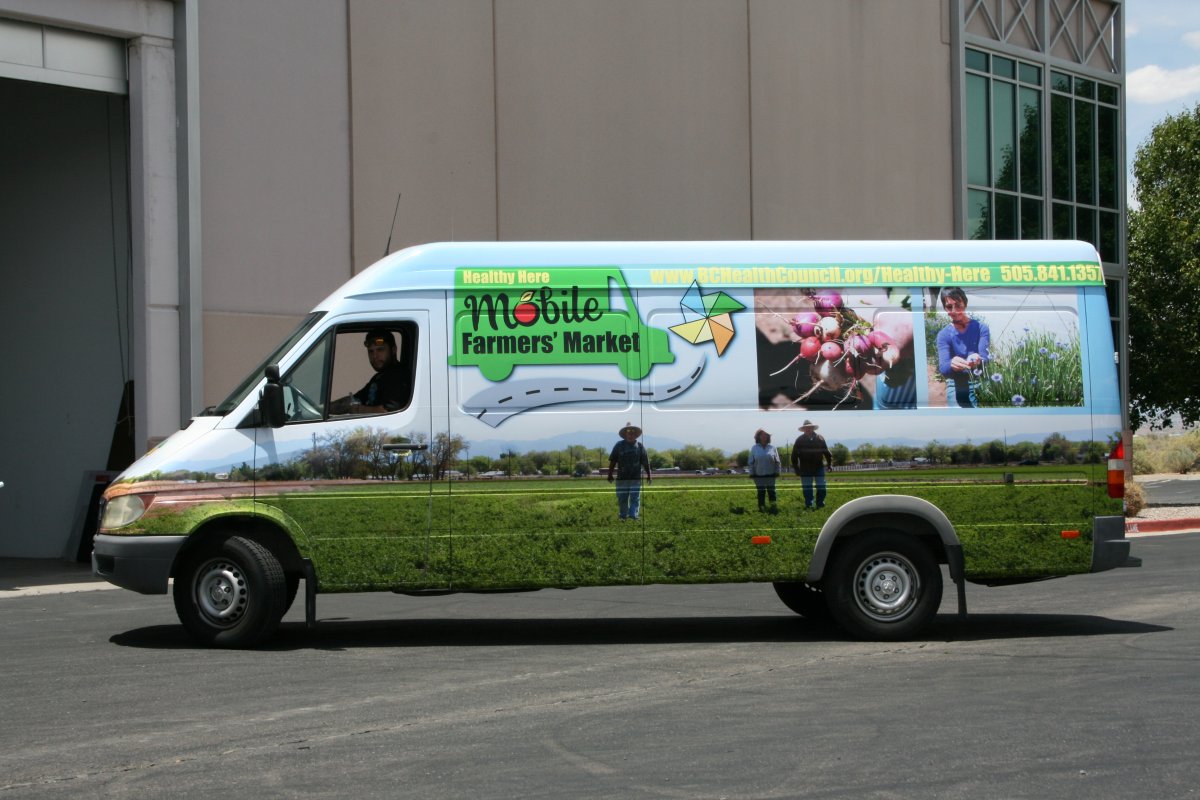
Integrating healthy food into the health care system
Not only has Presbyterian identified healthy eating as a community health priority, but they are also committed to addressing food issues within their hospital walls. In fall 2015, they committed to Health Care Without Harm’s Healthy Food in Health Care Pledge and made purchasing changes to include meat and poultry raised without routine antibiotics, rBGH-free milk, and organic fair trade coffee. Presbyterian Hospital has made environmental changes that support healthy eating by hosting an on-site farmers market, maintaining a garden on the hospital grounds, and revamping the vending machines to include a healthier product mix.
With 11,000 employees system-wide, Presbyterian has a robust employee wellness program that includes complimentary fruit delivery, the “Pres Chopped” local food cooking challenge, and Salad Bar Bucks that incentivize fruit and vegetable purchases in the cafeteria.
The future of food at Presbyterian focuses on increasing local procurement, developing a comprehensive food policy, and continuing to invest in community-driven strategies that address healthy eating.



